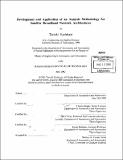Development and application of an analysis methodology for satellite broadband network architectures
Author(s)
Kashitani, Tatsuki, 1976-
DownloadFull printable version (3.685Mb)
Other Contributors
Massachusetts Institute of Technology. Dept. of Aeronautics and Astronautics.
Advisor
Charles Boppe and Paul Cefola.
Terms of use
Metadata
Show full item recordAbstract
An analysis methodology for analyzing the technical and economic performance of a satellite network system has been developed and implemented. It was applied to a set of satellite broadband network system designs based on the five systems in Ku-band recently proposed to the Federal Communications Commission. The considered systems represent satellite constellations with low Earth orbits (LEO), medium Earth orbits (MEO), and highly elliptic orbits (HEO). The technical and economic performance of the systems was evaluated by the metric: cost per billable T1 minute required to achieve an internal rate of return of 30 % with key technical requirements satisfied. The robustness of the system with respect to the fluctuation in the market size was also examined. Various assumptions were made to allow a unified comparison and modeling of the systems. As a consequence, the analyzed system designs are only similar to the FCC filings. The computed results show that the preferred system differs for different levels of market demand. The MEO and HEO systems are better in low demand scenarios. The LEO systems can support very large number of customers and achieve low cost per subscription in high demand scenarios. In terms of robustness to the market fluctuations, the HEO system, which has the ability to deploy by sub-constellation, showed an improved metric by adapting the deployment schedule to the demand size. A computer tool has been developed to automate this methodology in order to efficiently evaluate the performance metric from a set of design variables.
Description
Thesis (M.Eng.)--Massachusetts Institute of Technology, Dept. of Aeronautics and Astronautics, 2002. Includes bibliographical references (p. 75-78).
Date issued
2002Department
Massachusetts Institute of Technology. Department of Aeronautics and AstronauticsPublisher
Massachusetts Institute of Technology
Keywords
Aeronautics and Astronautics.